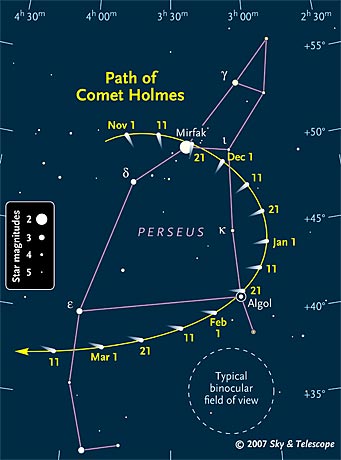
Northern Hemisphere observers can find Comet Holmes in the evening sky throughout the coming winter months. (Date marks are for 0:00 Universal Time.) Click on the map for a larger version.
Sky & Telescope
Moonlight aside, conditions remain good for seeing Comet Holmes. But as of November 18th the fuzzy new “star” in Perseus has lost a great deal of its surface brightness, and this week it's so close to the 2nd-magnitude star Alpha Persei (Mirfak) that the star interferes with its visibility. Use binoculars.
The fuzzy new object in Perseus erupted into naked-eye visibility on October 24th. Although the comet will eventually fade out, there’s no telling when — or whether a second outburst is in the cards, as happened in 1892–93. To track it during the coming weeks and months, use the finder chart at right.
As always, we want to know what you saw. Submit your photos to our Online Gallery. We’ve grouped the images into bundles spanning two weeks, so you can more easily watch the comet’s evolution over time.
In addition, we have a wide-field finder chart for finding the right part of the sky. And you can always customize a chart for your specific location, date, and time of night with our Interactive Sky Chart.
Clear skies!
 0
0
Comments
You must be logged in to post a comment.